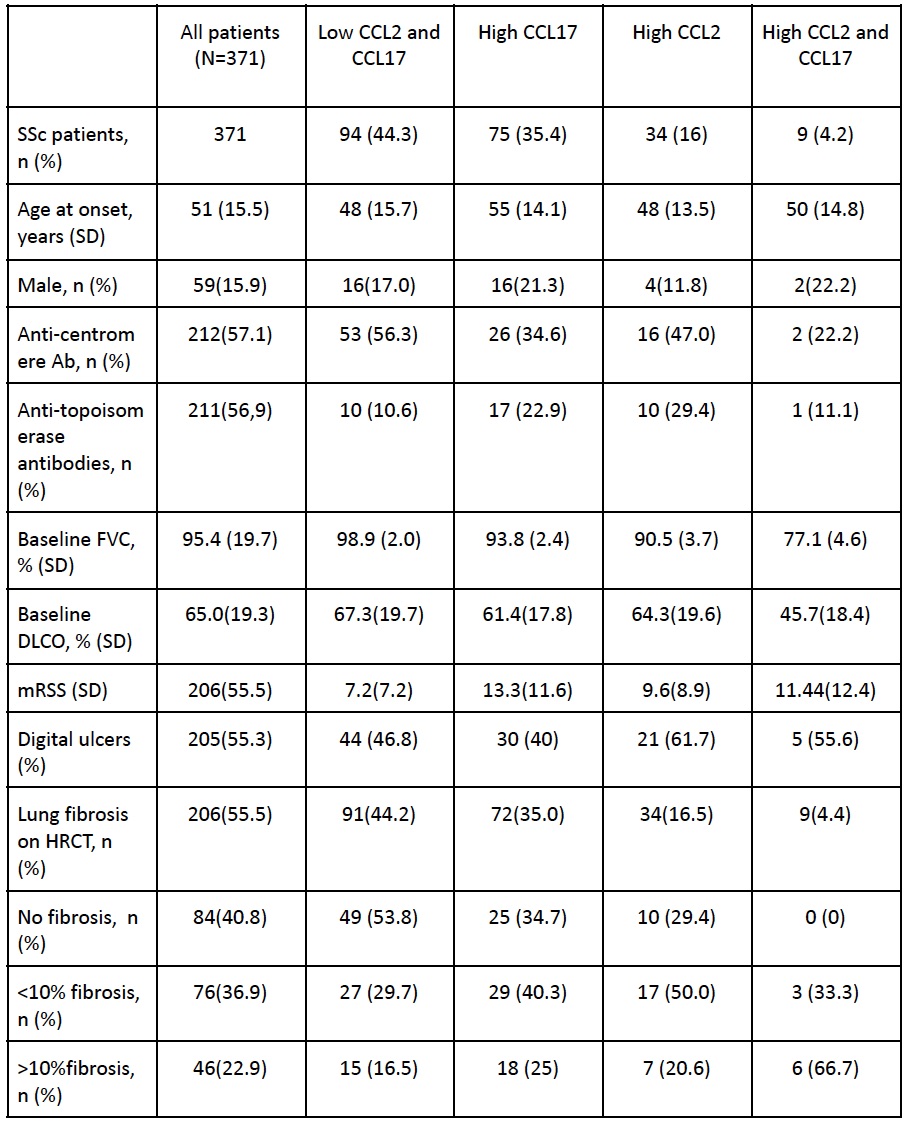Session Information
Date: Monday, November 8, 2021
Title: Systemic Sclerosis & Related Disorders – Clinical Poster II (1364–1390)
Session Type: Poster Session C
Session Time: 8:30AM-10:30AM
Background/Purpose: Systemic sclerosis (SSc) carries high risk for progressive interstitial lung disease (ILD). Several anti-inflammatory therapies have been used to treat SSc-ILD and recently the first antifibrotic therapy has been approved. Personalized treatment strategies are largely missing to date and it is unclear, which patients to treat with which treatment approach. The two chemokines, CCL2 (MCP-1) and CCL17 (TARC) have been shown to be markers of inflammation and fibrosis, respectively. The aim of this study was to examine associations between ILD characteristics and serum levels of CCL2 and CCL17 in a large and unselected SSc cohort with complete data sets on pulmonary function and lung fibrosis extent on HRCT.
Methods: Sera from the prospective Oslo University Hospital SSc cohort (n=371) and healthy blood donor controls (HC; n=100) were analyzed for CCL2 and CCL17 by multiplex assays. CCL2 and CCL17 levels were defined as high or low using 95% CI in HC sera as cut-off values. Paired pulmonary function tests and HRCT images were obtained at baseline and follow-up. All patients in the SSc cohort met the 2013 ACR/EULAR classification criteria. ILD was diagnosed on HRCT and categorized by the extent of lung fibrosis as limited (1-10%) or extensive ( >10%) ILD by semi-quantitative assessment. Descriptive statistics were applied.
Results: Of all 371 patients, 212 (57%) had available levels for circulating CCL2 and CCL17. These levels were significantly increased in SSc compared to HC (Figure). High levels of CCL17 ( >700 pg/ml) and CCL2 ( >1000pg/ml) were identified in 43/254 (17%) and 84/471 (18%) of the SSc patients, respectively (Table). High levels of both CCL17 and CCL2 were associated with lower FVC at baseline and a higher extent of lung fibrosis on HRCT (Table). Of those with high CCL2 and CCL17, 67% had extensive lung fibrosis on HRCT. Categorization of ILD into no ILD, limited or extensive ILD showed a numerical association between high CCL17 levels and the extent of fibrosis (Table).
Conclusion: In this explorative SSc cohort study, high levels of both CCL2 and CCL17 were associated with more severe ILD, potentially mirroring ongoing inflammatory and fibrotic processes, which may have an implication on treatment choices for SSc-ILD.
 Table 1. Demographics and clinical findings in the SSc cohort stratified by level of CCL2 and CCL17
Table 1. Demographics and clinical findings in the SSc cohort stratified by level of CCL2 and CCL17
 Figure 1. CCL17(TARC) levels and extent of lung fibrosis
Figure 1. CCL17(TARC) levels and extent of lung fibrosis
To cite this abstract in AMA style:
Barua I, Fretheim H, Bjørkekjær H, Didriksen H, Midtvedt O, AAløkken T, Garen T, Molberg O, Belperio J, Hoffmann-Vold A. Chemokines CCL2 and CCL17 as Potential Serum Biomarkers for Interstitial Lung Disease in Systemic Sclerosis [abstract]. Arthritis Rheumatol. 2021; 73 (suppl 9). https://acrabstracts.org/abstract/chemokines-ccl2-and-ccl17-as-potential-serum-biomarkers-for-interstitial-lung-disease-in-systemic-sclerosis/. Accessed .« Back to ACR Convergence 2021
ACR Meeting Abstracts - https://acrabstracts.org/abstract/chemokines-ccl2-and-ccl17-as-potential-serum-biomarkers-for-interstitial-lung-disease-in-systemic-sclerosis/
